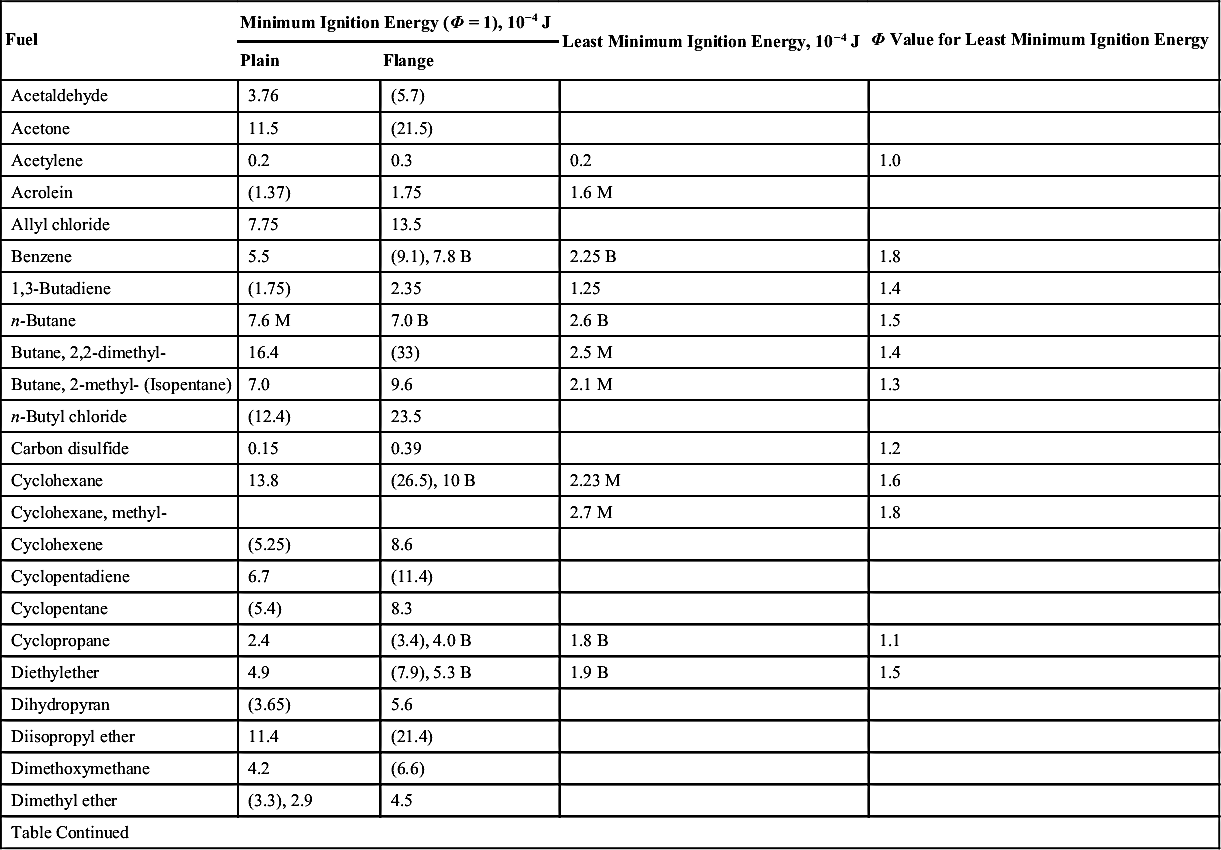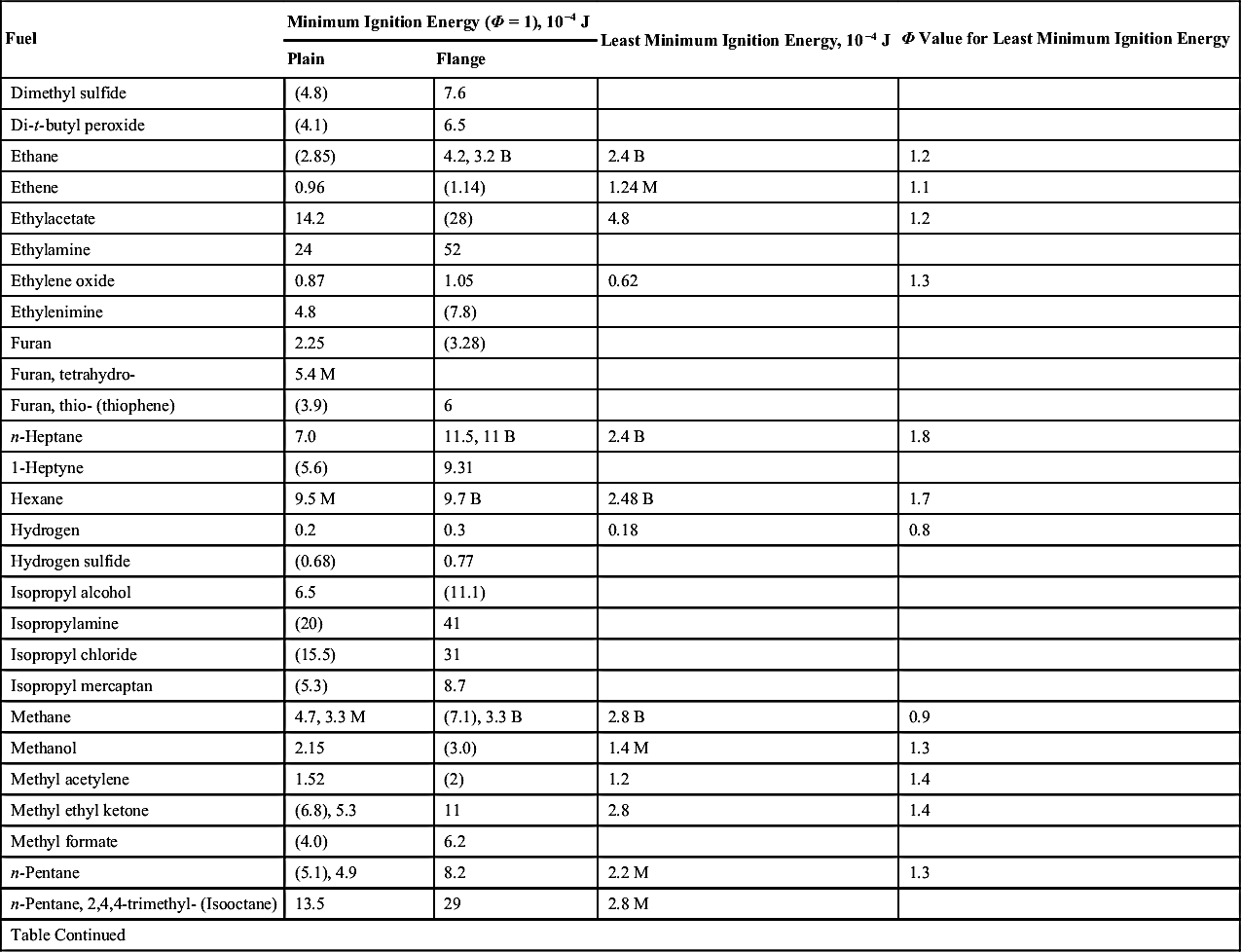Appendix H
Minimum spark ignition energies and quenching distances
Most of the data presented in Table H1 are taken from Calcote et al. [Ind Eng Chem 44, 2656 (1952)]. Additional data by Blanc et al. [Proceedings of the Combustion Institute 25, 1341–1347 (1994)] and Meltzer [NACA RM E53H31 (1953) and NACA RM E52 F27 (1952)] given in the table are designated by the letters B and M, respectively. Since the values for the least minimum ignition energy by Meltzer were extrapolated from low pressures, these values were not given if values by Calcote et al. or Blanc et al. were available.
The column labeled plain contains data from 1/8-inch rod electrodes and that labeled flange contains data for the negative electrode flanged and the other electrode a 1/8-inch rod. Values in parentheses are taken from a Calcote et al. correlation between the two different types of electrode sets.
Quenching distances can be obtained from the data presented in Table H1 and the correlation given as Figure 5 of Chapter 7. It is interesting to note that the most stable fuels have the least minimum ignition energy in the region of 0.2 mJ.
Table H1
Minimum Spark Ignition Energy Data for Fuels in Air at 1 atm Pressure
| Fuel | Minimum Ignition Energy (Φ = 1), 10−4 J | Least Minimum Ignition Energy, 10−4 J | Φ Value for Least Minimum Ignition Energy | |
| Plain | Flange | |||
| Acetaldehyde | 3.76 | (5.7) | ||
| Acetone | 11.5 | (21.5) | ||
| Acetylene | 0.2 | 0.3 | 0.2 | 1.0 |
| Acrolein | (1.37) | 1.75 | 1.6 M | |
| Allyl chloride | 7.75 | 13.5 | ||
| Benzene | 5.5 | (9.1), 7.8 B | 2.25 B | 1.8 |
| 1,3-Butadiene | (1.75) | 2.35 | 1.25 | 1.4 |
| n-Butane | 7.6 M | 7.0 B | 2.6 B | 1.5 |
| Butane, 2,2-dimethyl- | 16.4 | (33) | 2.5 M | 1.4 |
| Butane, 2-methyl- (Isopentane) | 7.0 | 9.6 | 2.1 M | 1.3 |
| n-Butyl chloride | (12.4) | 23.5 | ||
| Carbon disulfide | 0.15 | 0.39 | 1.2 | |
| Cyclohexane | 13.8 | (26.5), 10 B | 2.23 M | 1.6 |
| Cyclohexane, methyl- | 2.7 M | 1.8 | ||
| Cyclohexene | (5.25) | 8.6 | ||
| Cyclopentadiene | 6.7 | (11.4) | ||
| Cyclopentane | (5.4) | 8.3 | ||
| Cyclopropane | 2.4 | (3.4), 4.0 B | 1.8 B | 1.1 |
| Diethylether | 4.9 | (7.9), 5.3 B | 1.9 B | 1.5 |
| Dihydropyran | (3.65) | 5.6 | ||
| Diisopropyl ether | 11.4 | (21.4) | ||
| Dimethoxymethane | 4.2 | (6.6) | ||
| Dimethyl ether | (3.3), 2.9 | 4.5 | ||
| Table Continued | ||||

| Fuel | Minimum Ignition Energy (Φ = 1), 10−4 J | Least Minimum Ignition Energy, 10−4 J | Φ Value for Least Minimum Ignition Energy | |
| Plain | Flange | |||
| Dimethyl sulfide | (4.8) | 7.6 | ||
| Di-t-butyl peroxide | (4.1) | 6.5 | ||
| Ethane | (2.85) | 4.2, 3.2 B | 2.4 B | 1.2 |
| Ethene | 0.96 | (1.14) | 1.24 M | 1.1 |
| Ethylacetate | 14.2 | (28) | 4.8 | 1.2 |
| Ethylamine | 24 | 52 | ||
| Ethylene oxide | 0.87 | 1.05 | 0.62 | 1.3 |
| Ethylenimine | 4.8 | (7.8) | ||
| Furan | 2.25 | (3.28) | ||
| Furan, tetrahydro- | 5.4 M | |||
| Furan, thio- (thiophene) | (3.9) | 6 | ||
| n-Heptane | 7.0 | 11.5, 11 B | 2.4 B | 1.8 |
| 1-Heptyne | (5.6) | 9.31 | ||
| Hexane | 9.5 M | 9.7 B | 2.48 B | 1.7 |
| Hydrogen | 0.2 | 0.3 | 0.18 | 0.8 |
| Hydrogen sulfide | (0.68) | 0.77 | ||
| Isopropyl alcohol | 6.5 | (11.1) | ||
| Isopropylamine | (20) | 41 | ||
| Isopropyl chloride | (15.5) | 31 | ||
| Isopropyl mercaptan | (5.3) | 8.7 | ||
| Methane | 4.7, 3.3 M | (7.1), 3.3 B | 2.8 B | 0.9 |
| Methanol | 2.15 | (3.0) | 1.4 M | 1.3 |
| Methyl acetylene | 1.52 | (2) | 1.2 | 1.4 |
| Methyl ethyl ketone | (6.8), 5.3 | 11 | 2.8 | 1.4 |
| Methyl formate | (4.0) | 6.2 | ||
| n-Pentane | (5.1), 4.9 | 8.2 | 2.2 M | 1.3 |
| n-Pentane, 2,4,4-trimethyl- (Isooctane) | 13.5 | 29 | 2.8 M | |
| Table Continued | ||||

| Fuel | Minimum Ignition Energy (Φ = 1), 10−4 J | Least Minimum Ignition Energy, 10−4 J | Φ Value for Least Minimum Ignition Energy | |
| Plain | Flange | |||
| 1-Pentene, 2,4,4-trimethyl- (Diisobutylene) | (9.6) | 17.5 | ||
| 2-Pentene | (5.1), 4.7 | 8.2 | 1.8 M | 1.6 |
| Propane | 3.05 | 5, 4.0 B | 2.5 | 1.3 |
| Propane, 2,2-dimethyl- (Neopentane) | 15.7 | (31) | ||
| Propane, 2-methyl- (Isobutane) | (5.2) | 8.5 | ||
| Propene | 2.82 | (4.18), 4.1 | ||
| Propionaldehyde | (3.25) | 4.9 | ||
| n-Propyl chloride | (10.8) | 20 | ||
| Propylene oxide | 1.9 | 2.1 | 1.4 | 1.4 |
| Tetrahydropyran | 12.1 | (23) | 2.2 M | 1.7 |
| Triethylamine | (7.5), 11.5 | 13 | ||
| Triptane | 10 | (18.2) | ||
| Vinyl acetate | (7.0) | 12.0 | ||
| Vinyl acetylene | 0.822 | (0.95) | ||

..................Content has been hidden....................
You can't read the all page of ebook, please click here login for view all page.
